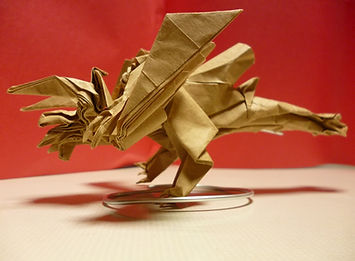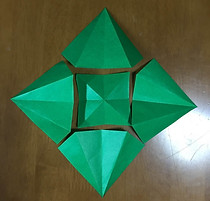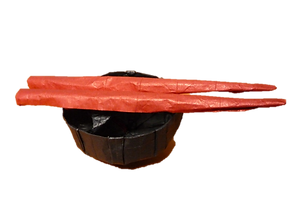
Open sink is sink fold to replace all the mounteins and valleys in the sinked part. The degree of freedom of the flap is high for closed sink.
It is said to be the most difficult in origami tequniques.
Fold to push the flaps into layers.




Tequnique of origami to make the flap.
Pinchi the corner and fold.
Technique of origami to bend the flaps.
It is counter to outside reverse fold.
Fold to push the corner inside.
Technique of origami to bend the flaps.
It is counter to inside reverse fold.
Fold to wrap the corner.
Diagram

Diagram shows a folding procedure.
In short, it is the figure in the origami books.
Even if you can't fold Crease Patterns, easily you can make.
In fact, it is more trouble to draw diagram than fold the work.
Diagram
Closed sink is to fold pushed into the inside without opening the part.
The degree of freedom of the flaps is reduced to the opensink.

Closed sink
Wet folding
Open sink
Sink
Rabbit ear fold
Inside reverse fold
Outside reverse fold

This is forming a pleat by folding the paper.
Be careful which side is the upper side.
It is technique of folding the moistening paper.
sometimes is there that you can't fold for thickness of paper?
At that time, let's moistened paper.
Then, hey presto. You would be able to fold.
In this way when the moistened paper is soft and easy to be maintained shape.
However you have to choose the appropriate paper, it is color off, or distorted the paper.
Moreover, you have to moisten the paper moderately.
So it is quite difficult.
Pleat fold
Origami specialized magazine.
It have posted various works, and mainly simple works.
Monthly Origami Magazine
An organization with about 10000 members.
NIPPON ORIGAMI ASSOCIATION Co., Ltd. (NOA)
It aims at dissemination of origami culture as a hobby, education and rehabilitation effect.
I operate the "Tokyo-Origami museum" and issue "Monthly Origami Magazine".
NOA
Origami specialty magazine published by JAOS.
It is issued every other month.
Approximately 1500 subscribers per year.
It is not sold at a bookstore, and it is mailed by transferring annual subscription fee.
You can purchase back numbers as long as inventory is available.
Diagrams, crease pattern, and a state of the exhibition are posted.
Origami tanteidan
Origami specialized gallery.
We also sell books and various origami.
There are many books of complex works.
If you want to try paper which you have never used such as biotope or Leathac, online shop of it is convenient.
Origami House
JOAS
An organization with about 400 members.
Japan Origami Academic Society (JOAS).
Issuing a magazine "Origami Tanteidan", it manages origami specialty gallery "Origami House".
There are various colors, tightness, durable and easy to fold paper.
However, large paper (50 cm or more) is difficult to obtain.
Perfect paper for origami.
Because there are various thicknesses, choose what fits the work!
Paper coated with aluminum like gold and silver origami.
Or paper on which aluminum foil is pasted.
Once in mountain folding it is difficult to make a valley fold, it is charactristic.
However, it is easy to finish, there are many cases where pasting is almost not necessary.
Curved surface processing is also easy.
Biotope
Metal foil paper
Abbreviation for color wrapping paper.
Currently, production of Karape is finished, New-Karape (production end, stock limit), t-Karape is being produced instead.
As its name suggests, there are many variations of colors and it is quite thin.
It is thin like a tissue.
It is hard to fold if trying to fold with only one pieceof paper.
Well, in fact it is scarcely folded with just a Karape, it is often used after pasting it on aluminum foil or other Karape.
Karape
It is tight and hard.
Also, once a mountain fold, it is hard to make a valley fold and it is characteristic.
Although it is not suitable for curved surface processing, it is suitable for mechanical and insects.
There are many white paper, but some are colored.
Tracing paper
Paper used for envelopes and others.
It is easy to fold, durable, moderately thin and large paper is also easy to obtain.
It is strongest paper! but the color is only brown.
There are also kraft paper with color, but there are few kinds of colors, it is not thin, the back is brown, it is not suitable for the finished work (for trial).
Let's use it for trial folding.
Kraft paper






One of theories for the design.
By combining yoko-bunshi, you can freely make flaps, but it is hard to combine if the shape of the yoko-bunshi is various.
Therefore, by fixing the shape of the yoko-bunshi to a square or a rectangle, it becomes easier to combine. Specifically, after making lengthwise and crosswise pleats crease, you make 45° angle crease. details are "this".
Box pleats
Cutting a group of uniaxial molecules (eg bird base) in parallel to the direction in which the flaps stretches makes it a tate-bunshi.
Tate-bunshi make it easier to understand the ratio of the size of the neighboring flaps.
Cutting a group of uniaxial molecules (eg the bird base) in the direction transverse to the direction in which the flaps stretches makes it a yoko-bunshi.
The yoko-bunshi shows the shape of the flaps itself, and it can tell at a glance how much paper area the flaps occupies.
It is what the edge is on a straight line when the molecule is folded.
Many complex works have combinations of uniaxal molecules.
A group of atoms.
Although not a base, there are several structures of templates.
In addition, there are many cases where creation is made by combination of uniaxial molecule.
The part surrounded by line segments of the crease pattern.
I will not pay much attention unless the figure appearing in the table is distinctive.
The theory that the area of paper used by flaps becomes a circle.
Please see "theory" in detail.
This theory is used as the basis of many creation theories.
Also, Robert J. Lang is good at design using circle packing.
Although I think that you will understand when you design, there are times when paper parts (wasted areas) that can not be used as flaps, as decoration, or as an internal structure can be maked.
If paper efficiency is bad, the work becomes thicker, and it becomes difficult to fold considerably especially in the complex works.
Drawing software to draw crease pattern created by Jun Mitani.
It is most suitable for drawing a crease pattern.
It also has a folding function of a crease pattern.
To fold the work only with crease pattern and the photograph of the work.
You mast fold the basic structure by a crease pattern and finish by photograph of the work.
A figure when spreading a work after folding. Often written in a simplified form. When designing or preserving the work, it play a role in design drawing.
To design about way of folding.
The design is basically free, but theory is often used to design complex works.
Simple works are often designed by not theory, but trial and error
Design
Theory of application of box pleats.
In the box pleats, only the crease of 45 degrees is used, but in the rational angle system, in addition to that, the angle of 1: 2, 1: 3, 3: 4, 1:7 is used.
And the Kamiya pattern is the most basic rational angle system.
It is used to eliminate unnecessary areas and to adjust angle.
It is still under development.
Rational angle system
Tate-bunshi
Yoko-bunshi
Uniaxial molecule
Molecule
Atom
Circle packing
Efficiency
ORIPA
Crease pattern fold
Crease pattern


Spread


If you draw crease pattern exactly, it simulate folded shape.

The light blue areas is a part that is not necessary for structural reasons (wasted areas)
Paper efficiency deteriorates when wasted areas are large.



Fold





This crease
45° angle crease




It is Works that make the contrast of color using the front and back color of paper.
Explanation is necessary because it seems to be using multiple paper even if use only one paper.
Inside-out
It is works with cracks on the ventral side.
A lot of mammal's works are it.
Effective for design that require a big flap on the belly side.
It can be said also to back-opening, there is no definite definition.
It is works with cracks on the back side.
How to fold the middle flap to the belly side.
Effective for works that require a big flap on the dorsal side.
It can be said also to belly-opening, there is no definite definition.
Back-opening
A structure in which a mountain fold and a valley fold line up in parallel, and literally becomes a bellows shape.
It sometimes refers to the box pleats.
when you want to design, you can add pleats without breaking the original crease pattern, it is useful to increase number of flap and adjust the length of flap.
There is a possibility that wasted space may increase, so try not to overuse it.
In addition, although the way of inserting a pleats is free, usually a pleats is parallel to the side of the paper or the diagonal of the paper.
Structure constructed with 15 degrees and the angle of multiples thereof.
Specifically a combination of molecules such as right.
Pleats
Structure constructed with 22.5 degrees and the angle of multiples thereof.
Specifically a combination of molecules such as right.
For example traditional bird is 22.5 degrees structure.
Works that use a specific angle and a lot of angle of multiples thereof such as 22.5 °structure.
It would be easy to understand by looking at the crease pattern.
Using specific angles, you are easy to design .
So a lot of complex works is the angle structure.
Angle grid system
Works that combined some units of same structure.
It is often a geometric works.
Modular origami
Works that is symmetrical with respect to the a line parallel to an edge and passing through the center of the paper in the crease pattern.
Many of the origami works are symmetry, what are divided into book symmetry and diagonal symmetry.
Diagonal symmetry is suitable designing by grafting and easy to improve proportion.

Symmetrical

Symmetrical


Works that is symmetrical with respect to the diagonal of the square in the crease pattern.
Many of the origami works are symmetry, what are divided into book symmetry and diagonal symmetry.
Book symmetry is suitable designing by box pleating.
The works folded without cutting a piece of square paper.
It is said that the most common origami.
Traditional works and complex works are often make from uncut squares.
Fusetsu-sehouke-itimaiori
Folding without cutting a single square!
Trditional origami such as Bird and Yakkosan.
It is copyright-free origami.
However, remodeling it is copyrighted by designer.
Traditional works
However there isn't clear definition, it is works that folding step or elements such as flaps are many.
If you make the complex work, the large paper and a lot of time will be necessary.
It is often designed by theory and grafted base and folded with a piece of square paper.
Because it is hard to draw a diagram, often you have to make it with only crease pattern.

Simple works
However there isn't clear definition, it is works that folding step or elements such as flaps are small.
It is easy to draw the diagram, and in many cases to introduce how to fold in such as video.
It looks easy to design in comparison with the complex works, time for design does not change much.
The reason is the difficulty of the simplification, which is the same as the difficulty to draw a picture with a small number of dots.
In addition, also the point that the design techniques can't use contribute to the difficulty.
Even simple works are protect by copyright.
If you exhibit and post on the web the works, you have to describe designer name.
Complex works
Belly-opening
Diagonal symmetry

Book symmetry
22.5° Grid System
15° Grid System







Moleculer 1
Moleculer 2


Assemble
Design by Miyuki Kawamura
"Geosphere"

Back-opening
Belly-opening


Moleculer 1
Moleculer 2

Two big flaps and two small flaps.
It is the most fomous base in Japan.
4 big flaps and 1 small flap.


Five big flaps and four small flaps.
It is four fish bases joined.
Ayame base
Fish base
It is four bird bases joined.
It is used in many complex work and easy to use even original pattern. How to use the interior flaps is important.
Bird base
Four bird base
Kotori base
Base
1: Usually used base. Many works are made by selecting the appropriate base and finishing. The following is to explain the bases of the meaning of 1.
2: State before finishing the origami work.
It is a state of group of flaps, and shape is far from the finished work.
Base that is often used to dragon.
Originally it does not mean there is a way of folding a fixed, be to make four large flaps in the four corners of the paper and four small middle flap.
It is often obtained by adding the diagonal line of the pleats to the bird base.

1 big flap and 3 small flaps.
It is easy to use even while the original.
And zabuton kotori base is famous and useful, what is combined with blintzed base.





Dragon out of the bird base
Flap
Flaps that folded from not the edge but the center of paper.
For example, triangle of the back of the traditional bird.
It is harder and more difficult to fold than other flaps.
In addition, difficult to sink fold.
If you look in terms of the circule packing, the big middle flaps use a lot of area.
So it isn't efficiency.
It is often used in a simple structure from the reason.
However, since we can not use too much just on the edge of the paper, it is important how to use the middle flaps.
It is used to thick flaps such as a legs of person.
Things are pointed part.
For example, there are 4 large flaps and 1 small flap in right figure.
If you want to design by the origami, must make flaps the same number as the pointed part of model.
Theory (circle packing, box pleating) is used to make flaps of necessary number.
For example, if you want to design a human form, it requires 4 large flaps for the limbs, and a small flap for the head.
Then you would be able to make it smoothly using bird base.
middle flap



The tree graph is a diagram showing the size of the flaps by the line.
In fact, when folding to the plane, you can see it from the side.
Often draw at the beginning of the design.
Also, if you enter the tree graph, there is a software called TreeMaker to output a crease pattern to be able to fold same as its tree graph.
Tree graph

Tree graph
What actually folded

Middle flap